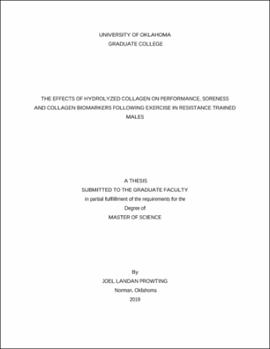| dc.description.abstract | Hydrolyzed Collagen (HCOL) is a nutritional supplement that has recently been suggested to enhance musculoskeletal (MSK) resilience and recovery from damaging exercise. Despite some promising evidence in clinical and in vitro models, there is a paucity of data in regards to its efficacy in healthy, exercising humans. PURPOSE: The purpose of this study was to determine whether consuming a HCOL supplement could be beneficial for well-trained individuals by examining the effect on acute recovery from high-force eccentric exercise. METHODS: Resistance trained males consumed 15g per day of either HCOL or a cornstarch placebo (PLA) for 12-days. After 7-days, they had a number of outcome variables measured, including: maximal voluntary isometric contraction (MVIC), countermovement jump performance (CMJ), lower body soreness, pain pressure threshold (PPT) tests and collagen turnover biomarkers (PICP and ICTP). After collection of baseline measures, participants performed a muscle damage protocol (5 sets of 20 drop jumps from 60cm box) before having every variable measured again at the following time points: immediately post (IP), 24h post (24h), 48h post (48h) and 120h post (120h). RESULTS: In both groups, lower body muscle soreness assessed via VAS was significantly higher than PRE at 24h (p=0.001) and 48h (p=0.018), but had returned to baseline by 120h (p>0.05). MVIC in both legs showed a significant time effect (Left: p=0.007; Right: p=0.010) over the 5-day post damage period. These finding indicate that the participants were sufficiently damaged using the drop jump protocol. Compared to baseline (HCOL = 38.2±9.2cm vs. PLA = 38.7±7.8cm), CMJ height performance was maintained in the HCOL group at 24h, whereas the PLA group experienced a significant decline (24h: HCOL = 37.0±8.4cm vs. PLA = 33.7±7.6cm; p<0.001). Neither the collagen synthesis (PICP) or collagen breakdown (ICTP) biomarkers changed significantly. CONCLUSION: In summary, at the 24 h time point, HCOL attenuated the performance decline that is typically associated with muscle damage. This finding suggests that short term consumption of HCOL either enhanced tissue repair/recovery rate or reduced the magnitude of damage incurred by the drop jump protocol.
Key Words: Hydrolyzed Collagen, Recovery, Exercise Induced Muscle Damage, Connective Tissue | en_US |
